HRM 3160: Improving Leadership at Space Engineering Services (SES)
VerifiedAdded on 2023/04/25
|19
|3785
|417
Report
AI Summary
This report critically evaluates the strategic leadership and management development aspects of Space Engineering Services (SES), a refrigeration company experiencing rapid growth. The company's sudden expansion led to workforce management challenges, particularly with engineers assuming managerial roles without adequate training. This resulted in miscommunication, information gaps, and decreased employee morale. The report discusses essential managerial and leadership competencies, recommends an integrated leadership development approach, and addresses potential issues arising from LMD interventions. SES has implemented measures to mitigate risks and achieve overall success. The analysis includes a mind-map framing reference areas from 2010 to 2012 to enhance the effectiveness of results.
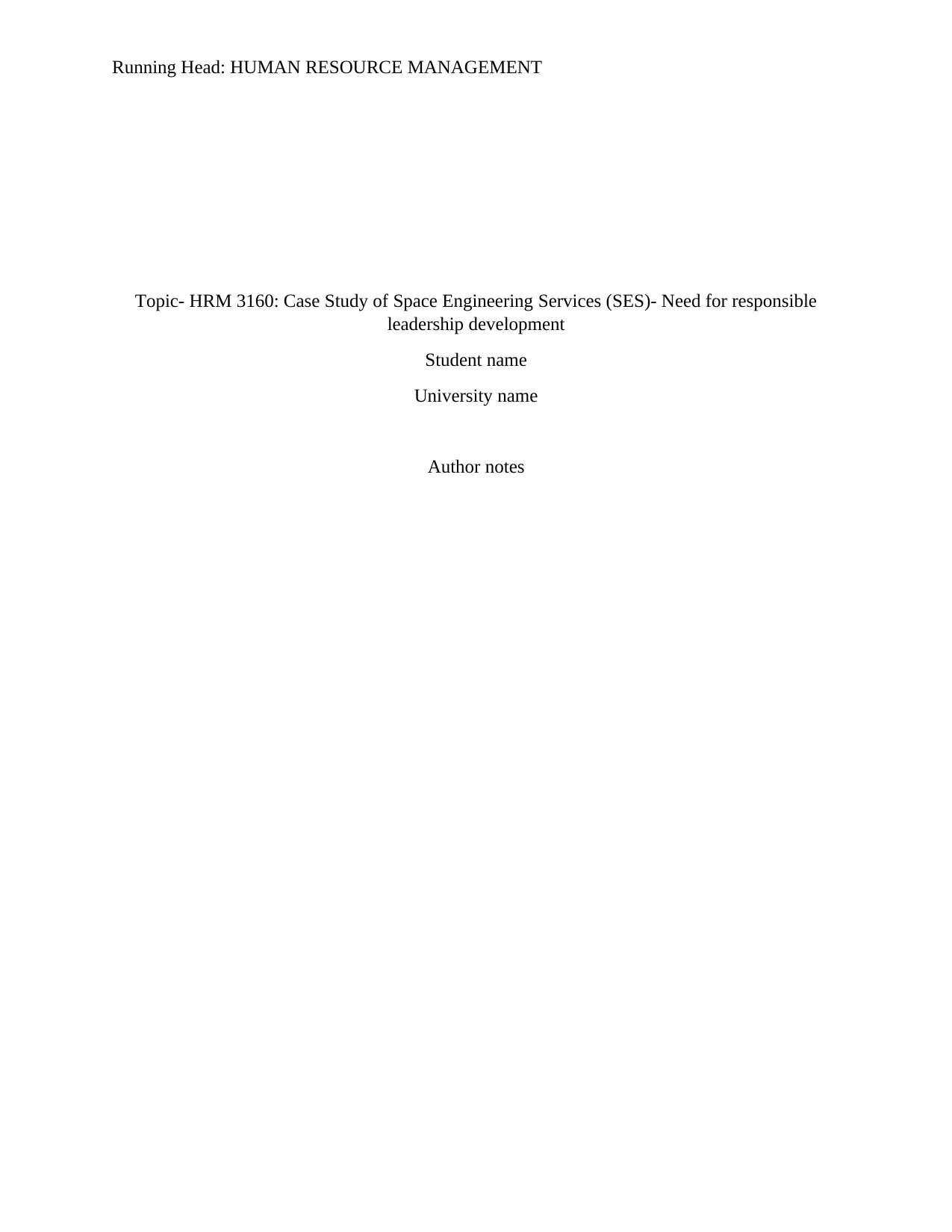
Running Head: HUMAN RESOURCE MANAGEMENT
Topic- HRM 3160: Case Study of Space Engineering Services (SES)- Need for responsible
leadership development
Student name
University name
Author notes
Topic- HRM 3160: Case Study of Space Engineering Services (SES)- Need for responsible
leadership development
Student name
University name
Author notes
Paraphrase This Document
Need a fresh take? Get an instant paraphrase of this document with our AI Paraphraser
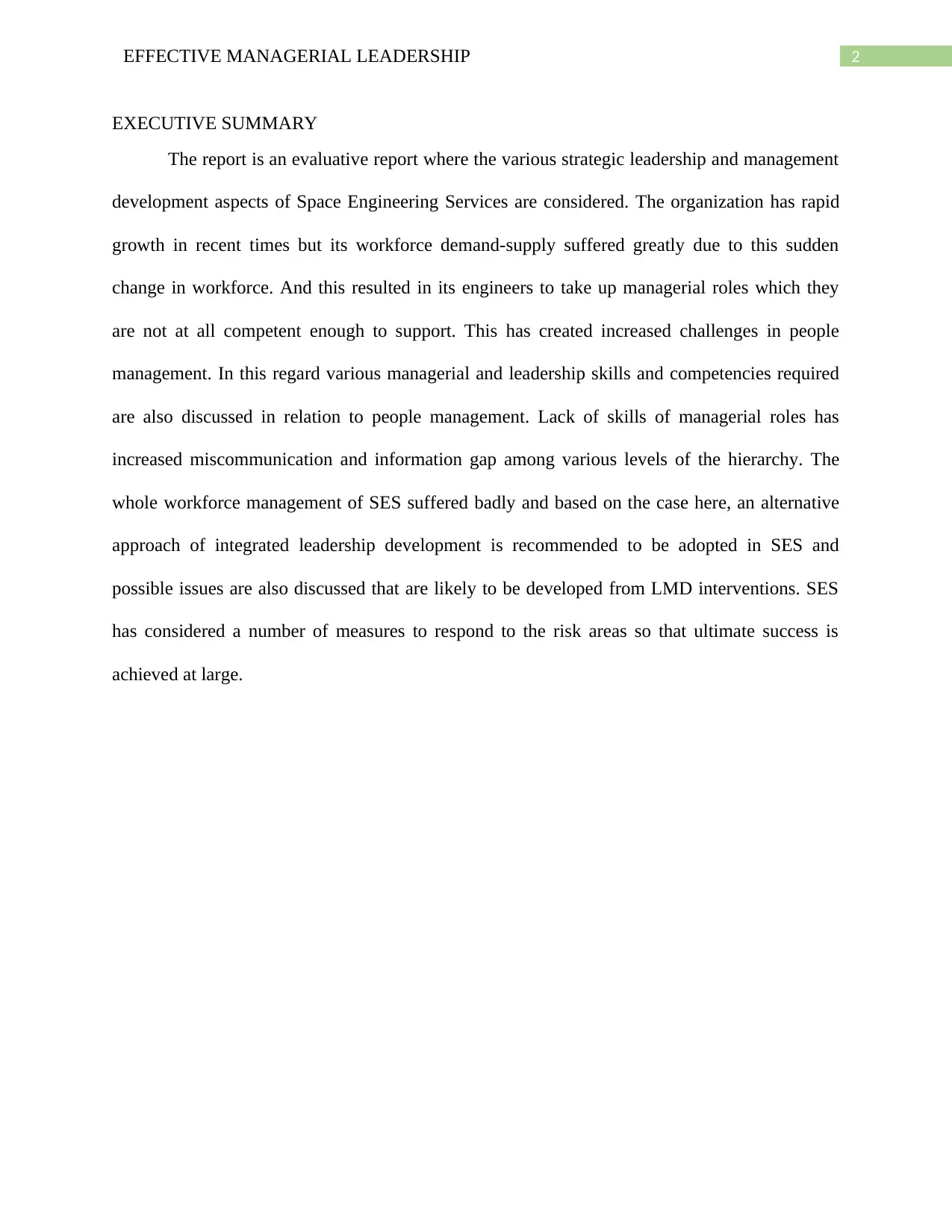
2EFFECTIVE MANAGERIAL LEADERSHIP
EXECUTIVE SUMMARY
The report is an evaluative report where the various strategic leadership and management
development aspects of Space Engineering Services are considered. The organization has rapid
growth in recent times but its workforce demand-supply suffered greatly due to this sudden
change in workforce. And this resulted in its engineers to take up managerial roles which they
are not at all competent enough to support. This has created increased challenges in people
management. In this regard various managerial and leadership skills and competencies required
are also discussed in relation to people management. Lack of skills of managerial roles has
increased miscommunication and information gap among various levels of the hierarchy. The
whole workforce management of SES suffered badly and based on the case here, an alternative
approach of integrated leadership development is recommended to be adopted in SES and
possible issues are also discussed that are likely to be developed from LMD interventions. SES
has considered a number of measures to respond to the risk areas so that ultimate success is
achieved at large.
EXECUTIVE SUMMARY
The report is an evaluative report where the various strategic leadership and management
development aspects of Space Engineering Services are considered. The organization has rapid
growth in recent times but its workforce demand-supply suffered greatly due to this sudden
change in workforce. And this resulted in its engineers to take up managerial roles which they
are not at all competent enough to support. This has created increased challenges in people
management. In this regard various managerial and leadership skills and competencies required
are also discussed in relation to people management. Lack of skills of managerial roles has
increased miscommunication and information gap among various levels of the hierarchy. The
whole workforce management of SES suffered badly and based on the case here, an alternative
approach of integrated leadership development is recommended to be adopted in SES and
possible issues are also discussed that are likely to be developed from LMD interventions. SES
has considered a number of measures to respond to the risk areas so that ultimate success is
achieved at large.
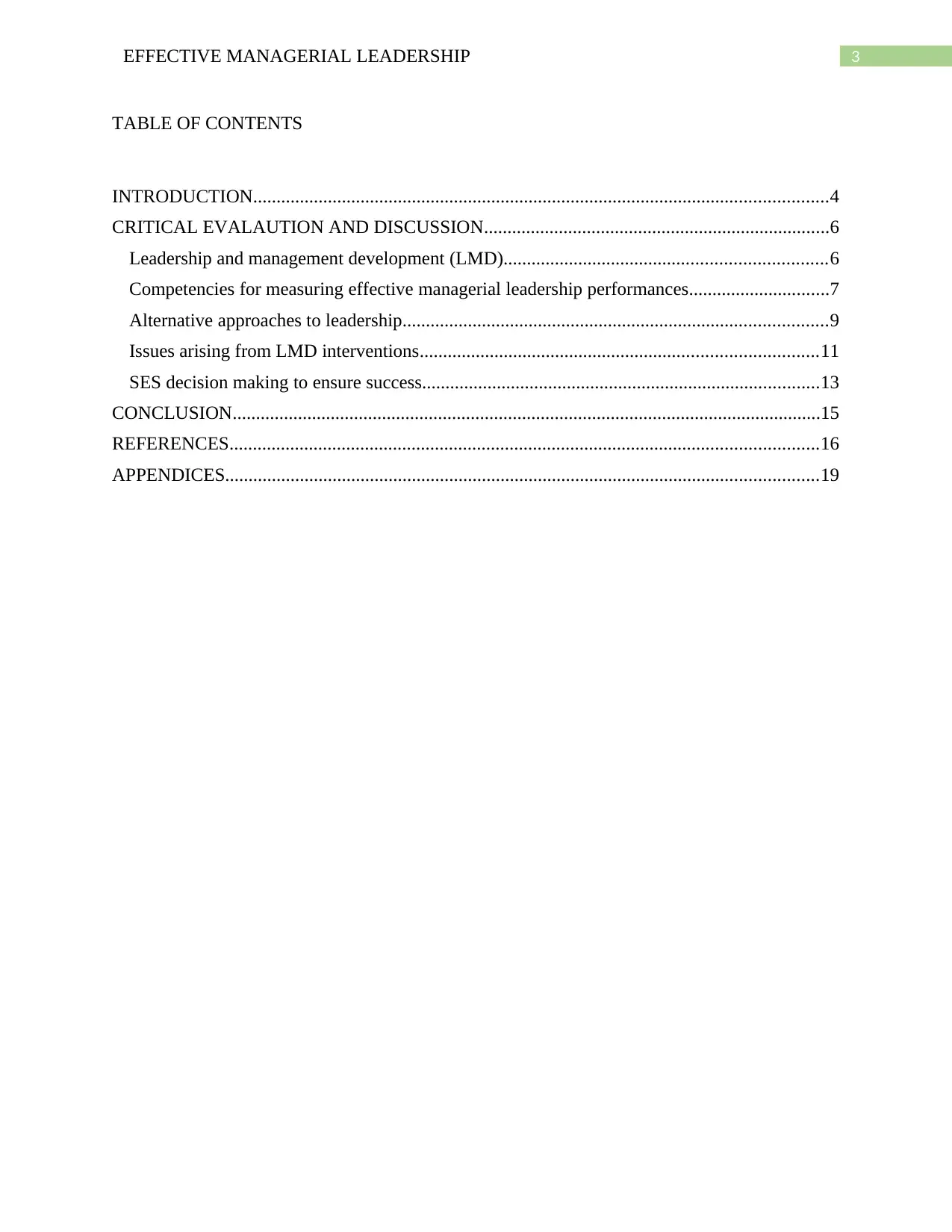
3EFFECTIVE MANAGERIAL LEADERSHIP
TABLE OF CONTENTS
INTRODUCTION...........................................................................................................................4
CRITICAL EVALAUTION AND DISCUSSION..........................................................................6
Leadership and management development (LMD).....................................................................6
Competencies for measuring effective managerial leadership performances..............................7
Alternative approaches to leadership...........................................................................................9
Issues arising from LMD interventions.....................................................................................11
SES decision making to ensure success.....................................................................................13
CONCLUSION..............................................................................................................................15
REFERENCES..............................................................................................................................16
APPENDICES...............................................................................................................................19
TABLE OF CONTENTS
INTRODUCTION...........................................................................................................................4
CRITICAL EVALAUTION AND DISCUSSION..........................................................................6
Leadership and management development (LMD).....................................................................6
Competencies for measuring effective managerial leadership performances..............................7
Alternative approaches to leadership...........................................................................................9
Issues arising from LMD interventions.....................................................................................11
SES decision making to ensure success.....................................................................................13
CONCLUSION..............................................................................................................................15
REFERENCES..............................................................................................................................16
APPENDICES...............................................................................................................................19
⊘ This is a preview!⊘
Do you want full access?
Subscribe today to unlock all pages.

Trusted by 1+ million students worldwide
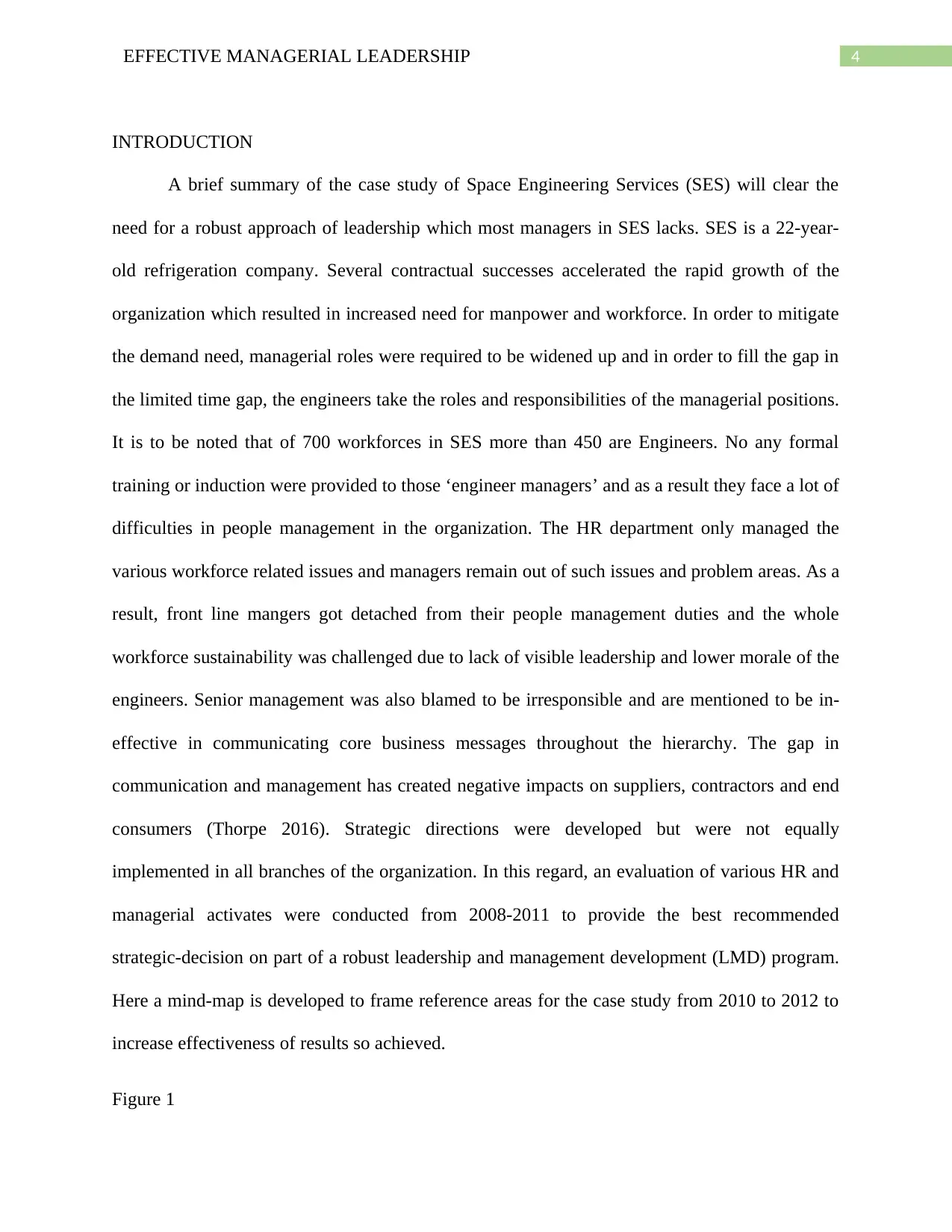
4EFFECTIVE MANAGERIAL LEADERSHIP
INTRODUCTION
A brief summary of the case study of Space Engineering Services (SES) will clear the
need for a robust approach of leadership which most managers in SES lacks. SES is a 22-year-
old refrigeration company. Several contractual successes accelerated the rapid growth of the
organization which resulted in increased need for manpower and workforce. In order to mitigate
the demand need, managerial roles were required to be widened up and in order to fill the gap in
the limited time gap, the engineers take the roles and responsibilities of the managerial positions.
It is to be noted that of 700 workforces in SES more than 450 are Engineers. No any formal
training or induction were provided to those ‘engineer managers’ and as a result they face a lot of
difficulties in people management in the organization. The HR department only managed the
various workforce related issues and managers remain out of such issues and problem areas. As a
result, front line mangers got detached from their people management duties and the whole
workforce sustainability was challenged due to lack of visible leadership and lower morale of the
engineers. Senior management was also blamed to be irresponsible and are mentioned to be in-
effective in communicating core business messages throughout the hierarchy. The gap in
communication and management has created negative impacts on suppliers, contractors and end
consumers (Thorpe 2016). Strategic directions were developed but were not equally
implemented in all branches of the organization. In this regard, an evaluation of various HR and
managerial activates were conducted from 2008-2011 to provide the best recommended
strategic-decision on part of a robust leadership and management development (LMD) program.
Here a mind-map is developed to frame reference areas for the case study from 2010 to 2012 to
increase effectiveness of results so achieved.
Figure 1
INTRODUCTION
A brief summary of the case study of Space Engineering Services (SES) will clear the
need for a robust approach of leadership which most managers in SES lacks. SES is a 22-year-
old refrigeration company. Several contractual successes accelerated the rapid growth of the
organization which resulted in increased need for manpower and workforce. In order to mitigate
the demand need, managerial roles were required to be widened up and in order to fill the gap in
the limited time gap, the engineers take the roles and responsibilities of the managerial positions.
It is to be noted that of 700 workforces in SES more than 450 are Engineers. No any formal
training or induction were provided to those ‘engineer managers’ and as a result they face a lot of
difficulties in people management in the organization. The HR department only managed the
various workforce related issues and managers remain out of such issues and problem areas. As a
result, front line mangers got detached from their people management duties and the whole
workforce sustainability was challenged due to lack of visible leadership and lower morale of the
engineers. Senior management was also blamed to be irresponsible and are mentioned to be in-
effective in communicating core business messages throughout the hierarchy. The gap in
communication and management has created negative impacts on suppliers, contractors and end
consumers (Thorpe 2016). Strategic directions were developed but were not equally
implemented in all branches of the organization. In this regard, an evaluation of various HR and
managerial activates were conducted from 2008-2011 to provide the best recommended
strategic-decision on part of a robust leadership and management development (LMD) program.
Here a mind-map is developed to frame reference areas for the case study from 2010 to 2012 to
increase effectiveness of results so achieved.
Figure 1
Paraphrase This Document
Need a fresh take? Get an instant paraphrase of this document with our AI Paraphraser
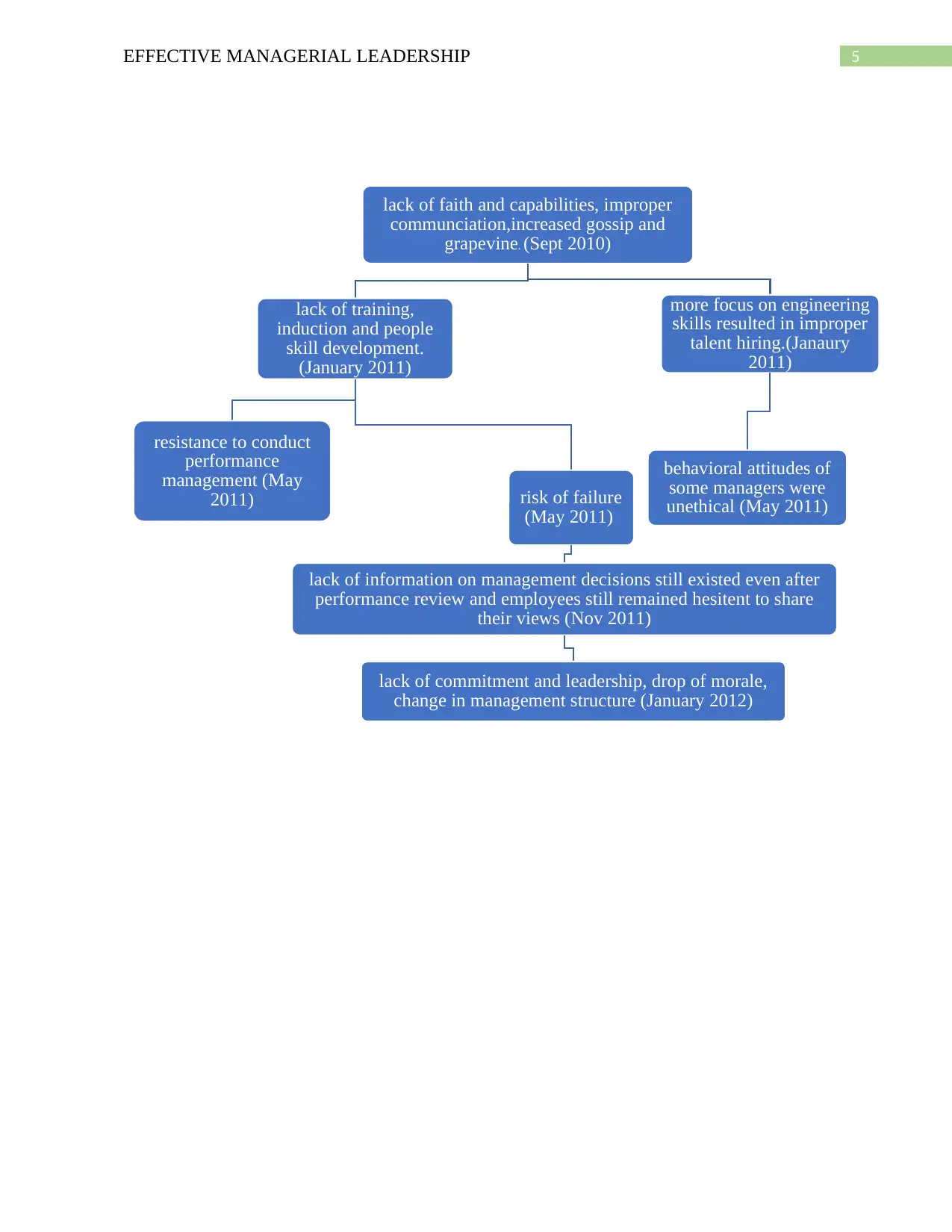
5EFFECTIVE MANAGERIAL LEADERSHIP
lack of faith and capabilities, improper
communciation,increased gossip and
grapevine. (Sept 2010)
lack of training,
induction and people
skill development.
(January 2011)
resistance to conduct
performance
management (May
2011) risk of failure
(May 2011)
lack of information on management decisions still existed even after
performance review and employees still remained hesitent to share
their views (Nov 2011)
lack of commitment and leadership, drop of morale,
change in management structure (January 2012)
more focus on engineering
skills resulted in improper
talent hiring.(Janaury
2011)
behavioral attitudes of
some managers were
unethical (May 2011)
lack of faith and capabilities, improper
communciation,increased gossip and
grapevine. (Sept 2010)
lack of training,
induction and people
skill development.
(January 2011)
resistance to conduct
performance
management (May
2011) risk of failure
(May 2011)
lack of information on management decisions still existed even after
performance review and employees still remained hesitent to share
their views (Nov 2011)
lack of commitment and leadership, drop of morale,
change in management structure (January 2012)
more focus on engineering
skills resulted in improper
talent hiring.(Janaury
2011)
behavioral attitudes of
some managers were
unethical (May 2011)
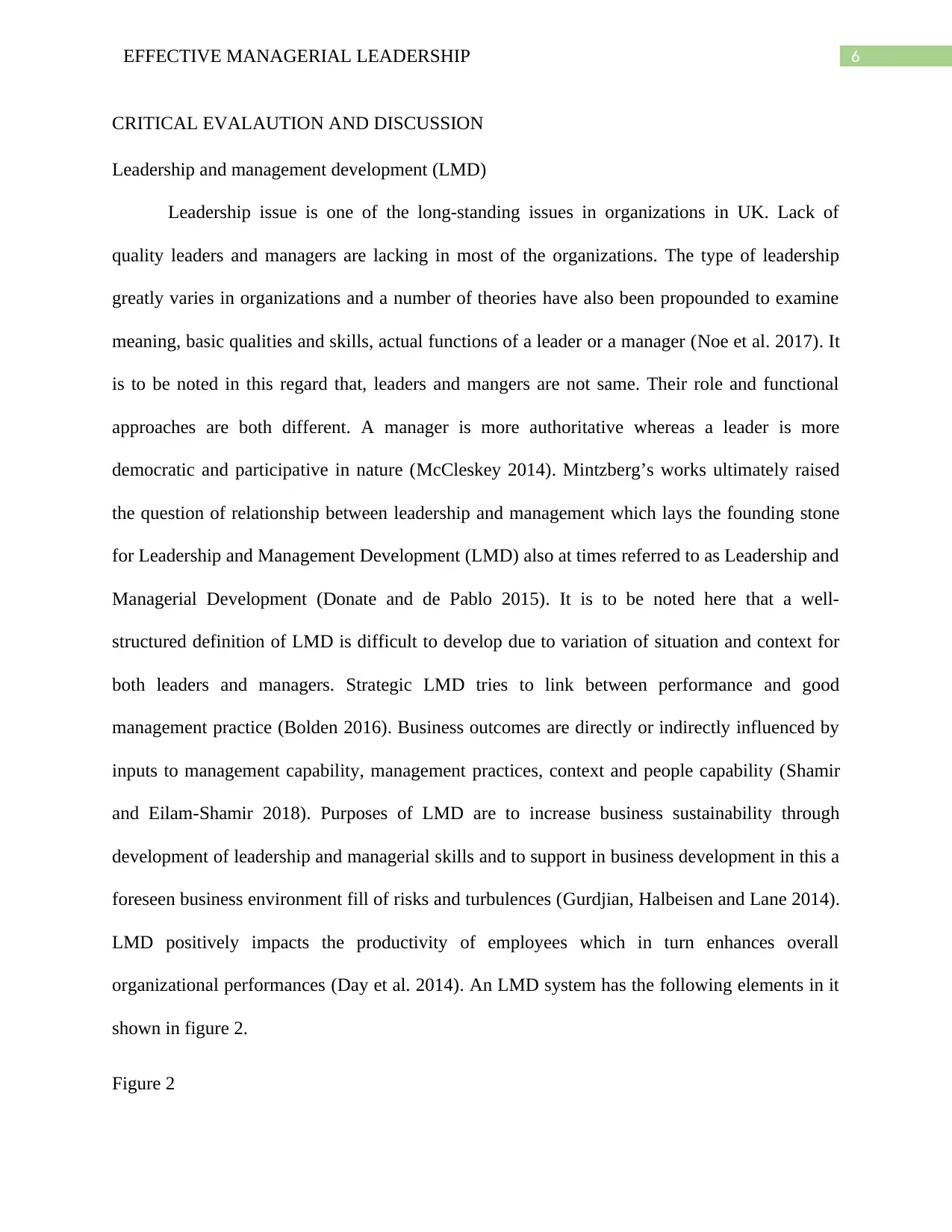
6EFFECTIVE MANAGERIAL LEADERSHIP
CRITICAL EVALAUTION AND DISCUSSION
Leadership and management development (LMD)
Leadership issue is one of the long-standing issues in organizations in UK. Lack of
quality leaders and managers are lacking in most of the organizations. The type of leadership
greatly varies in organizations and a number of theories have also been propounded to examine
meaning, basic qualities and skills, actual functions of a leader or a manager (Noe et al. 2017). It
is to be noted in this regard that, leaders and mangers are not same. Their role and functional
approaches are both different. A manager is more authoritative whereas a leader is more
democratic and participative in nature (McCleskey 2014). Mintzberg’s works ultimately raised
the question of relationship between leadership and management which lays the founding stone
for Leadership and Management Development (LMD) also at times referred to as Leadership and
Managerial Development (Donate and de Pablo 2015). It is to be noted here that a well-
structured definition of LMD is difficult to develop due to variation of situation and context for
both leaders and managers. Strategic LMD tries to link between performance and good
management practice (Bolden 2016). Business outcomes are directly or indirectly influenced by
inputs to management capability, management practices, context and people capability (Shamir
and Eilam-Shamir 2018). Purposes of LMD are to increase business sustainability through
development of leadership and managerial skills and to support in business development in this a
foreseen business environment fill of risks and turbulences (Gurdjian, Halbeisen and Lane 2014).
LMD positively impacts the productivity of employees which in turn enhances overall
organizational performances (Day et al. 2014). An LMD system has the following elements in it
shown in figure 2.
Figure 2
CRITICAL EVALAUTION AND DISCUSSION
Leadership and management development (LMD)
Leadership issue is one of the long-standing issues in organizations in UK. Lack of
quality leaders and managers are lacking in most of the organizations. The type of leadership
greatly varies in organizations and a number of theories have also been propounded to examine
meaning, basic qualities and skills, actual functions of a leader or a manager (Noe et al. 2017). It
is to be noted in this regard that, leaders and mangers are not same. Their role and functional
approaches are both different. A manager is more authoritative whereas a leader is more
democratic and participative in nature (McCleskey 2014). Mintzberg’s works ultimately raised
the question of relationship between leadership and management which lays the founding stone
for Leadership and Management Development (LMD) also at times referred to as Leadership and
Managerial Development (Donate and de Pablo 2015). It is to be noted here that a well-
structured definition of LMD is difficult to develop due to variation of situation and context for
both leaders and managers. Strategic LMD tries to link between performance and good
management practice (Bolden 2016). Business outcomes are directly or indirectly influenced by
inputs to management capability, management practices, context and people capability (Shamir
and Eilam-Shamir 2018). Purposes of LMD are to increase business sustainability through
development of leadership and managerial skills and to support in business development in this a
foreseen business environment fill of risks and turbulences (Gurdjian, Halbeisen and Lane 2014).
LMD positively impacts the productivity of employees which in turn enhances overall
organizational performances (Day et al. 2014). An LMD system has the following elements in it
shown in figure 2.
Figure 2
⊘ This is a preview!⊘
Do you want full access?
Subscribe today to unlock all pages.

Trusted by 1+ million students worldwide
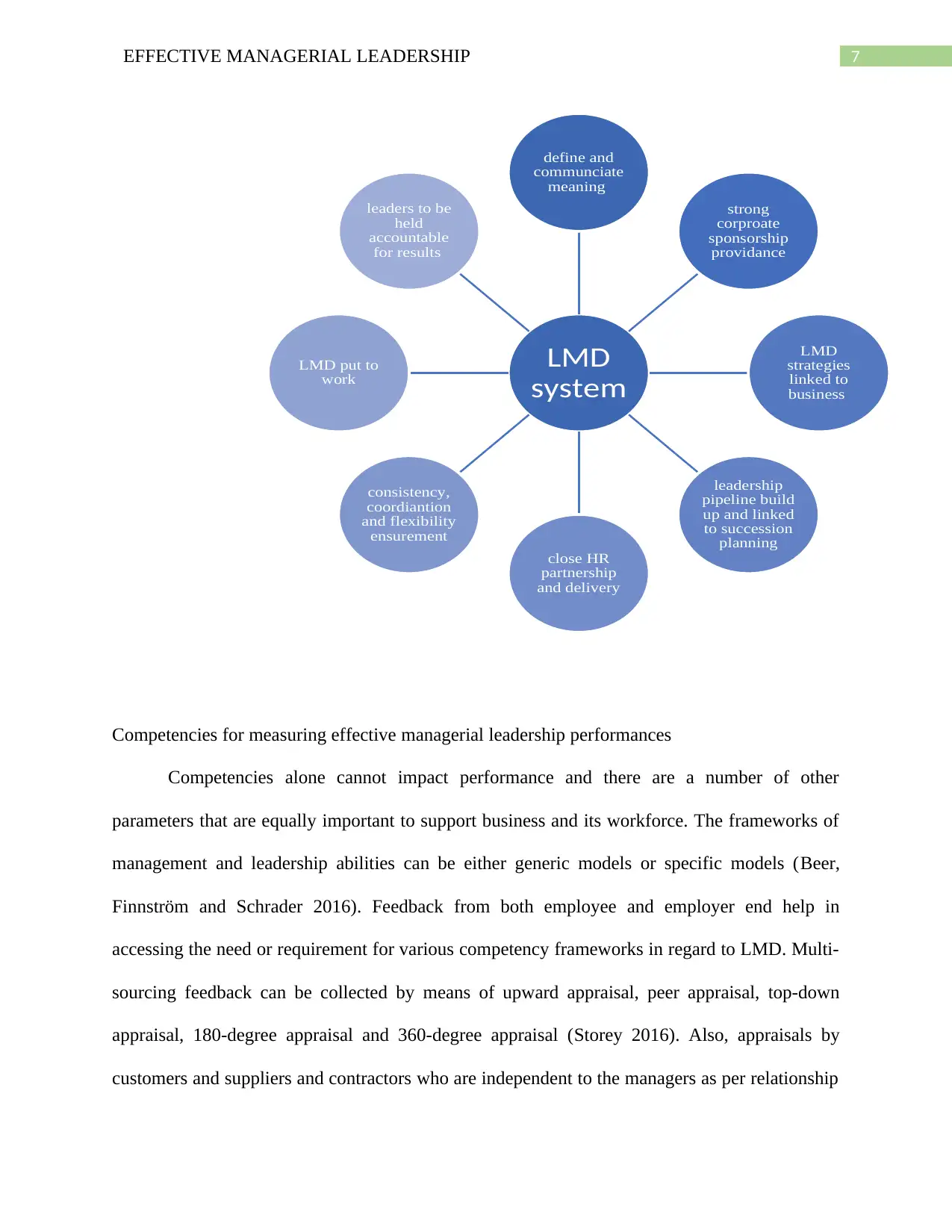
7EFFECTIVE MANAGERIAL LEADERSHIP
Competencies for measuring effective managerial leadership performances
Competencies alone cannot impact performance and there are a number of other
parameters that are equally important to support business and its workforce. The frameworks of
management and leadership abilities can be either generic models or specific models (Beer,
Finnström and Schrader 2016). Feedback from both employee and employer end help in
accessing the need or requirement for various competency frameworks in regard to LMD. Multi-
sourcing feedback can be collected by means of upward appraisal, peer appraisal, top-down
appraisal, 180-degree appraisal and 360-degree appraisal (Storey 2016). Also, appraisals by
customers and suppliers and contractors who are independent to the managers as per relationship
LMD
system
define and
communciate
meaning
strong
corproate
sponsorship
providance
LMD
strategies
linked to
business
leadership
pipeline build
up and linked
to succession
planning
close HR
partnership
and delivery
consistency,
coordiantion
and flexibility
ensurement
LMD put to
work
leaders to be
held
accountable
for results
Competencies for measuring effective managerial leadership performances
Competencies alone cannot impact performance and there are a number of other
parameters that are equally important to support business and its workforce. The frameworks of
management and leadership abilities can be either generic models or specific models (Beer,
Finnström and Schrader 2016). Feedback from both employee and employer end help in
accessing the need or requirement for various competency frameworks in regard to LMD. Multi-
sourcing feedback can be collected by means of upward appraisal, peer appraisal, top-down
appraisal, 180-degree appraisal and 360-degree appraisal (Storey 2016). Also, appraisals by
customers and suppliers and contractors who are independent to the managers as per relationship
LMD
system
define and
communciate
meaning
strong
corproate
sponsorship
providance
LMD
strategies
linked to
business
leadership
pipeline build
up and linked
to succession
planning
close HR
partnership
and delivery
consistency,
coordiantion
and flexibility
ensurement
LMD put to
work
leaders to be
held
accountable
for results
Paraphrase This Document
Need a fresh take? Get an instant paraphrase of this document with our AI Paraphraser
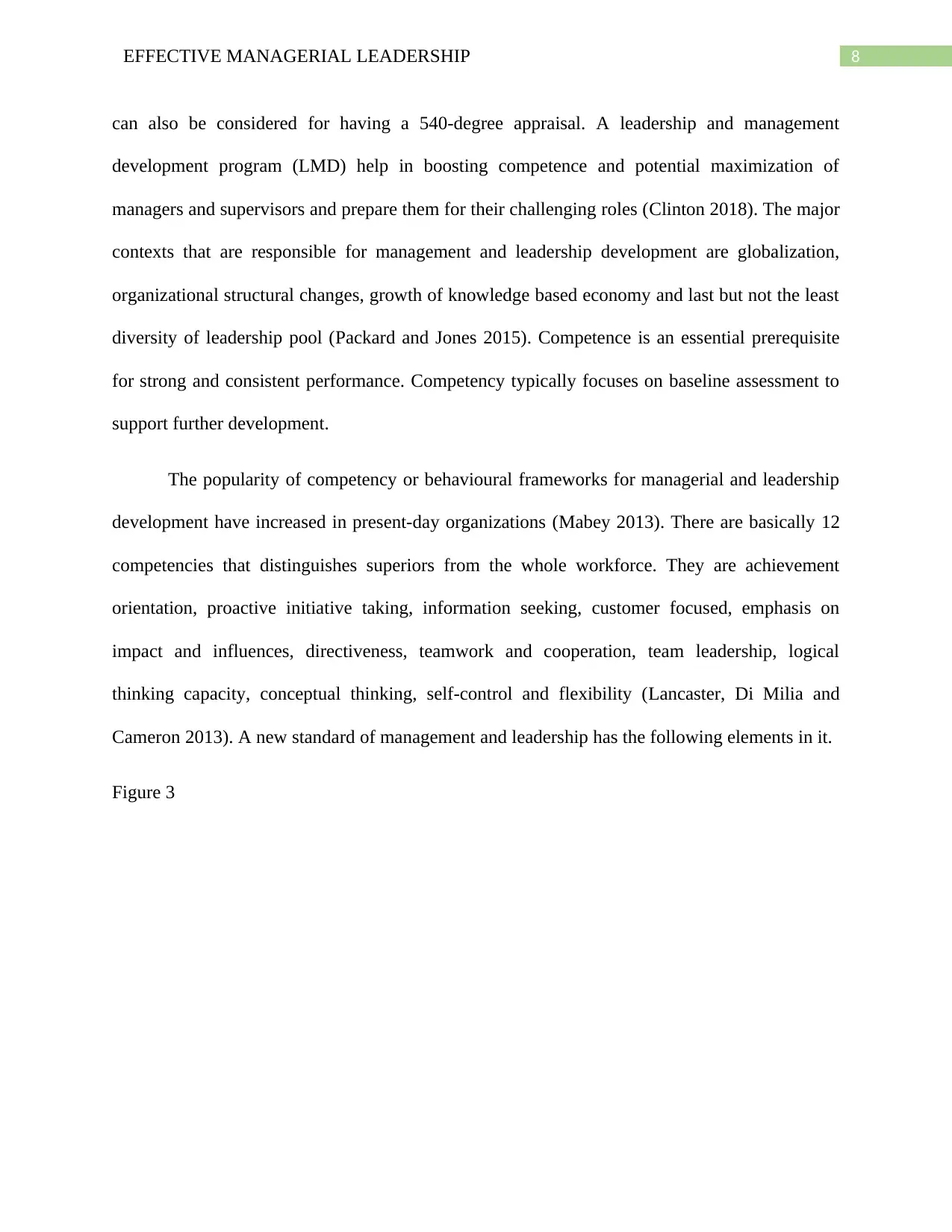
8EFFECTIVE MANAGERIAL LEADERSHIP
can also be considered for having a 540-degree appraisal. A leadership and management
development program (LMD) help in boosting competence and potential maximization of
managers and supervisors and prepare them for their challenging roles (Clinton 2018). The major
contexts that are responsible for management and leadership development are globalization,
organizational structural changes, growth of knowledge based economy and last but not the least
diversity of leadership pool (Packard and Jones 2015). Competence is an essential prerequisite
for strong and consistent performance. Competency typically focuses on baseline assessment to
support further development.
The popularity of competency or behavioural frameworks for managerial and leadership
development have increased in present-day organizations (Mabey 2013). There are basically 12
competencies that distinguishes superiors from the whole workforce. They are achievement
orientation, proactive initiative taking, information seeking, customer focused, emphasis on
impact and influences, directiveness, teamwork and cooperation, team leadership, logical
thinking capacity, conceptual thinking, self-control and flexibility (Lancaster, Di Milia and
Cameron 2013). A new standard of management and leadership has the following elements in it.
Figure 3
can also be considered for having a 540-degree appraisal. A leadership and management
development program (LMD) help in boosting competence and potential maximization of
managers and supervisors and prepare them for their challenging roles (Clinton 2018). The major
contexts that are responsible for management and leadership development are globalization,
organizational structural changes, growth of knowledge based economy and last but not the least
diversity of leadership pool (Packard and Jones 2015). Competence is an essential prerequisite
for strong and consistent performance. Competency typically focuses on baseline assessment to
support further development.
The popularity of competency or behavioural frameworks for managerial and leadership
development have increased in present-day organizations (Mabey 2013). There are basically 12
competencies that distinguishes superiors from the whole workforce. They are achievement
orientation, proactive initiative taking, information seeking, customer focused, emphasis on
impact and influences, directiveness, teamwork and cooperation, team leadership, logical
thinking capacity, conceptual thinking, self-control and flexibility (Lancaster, Di Milia and
Cameron 2013). A new standard of management and leadership has the following elements in it.
Figure 3
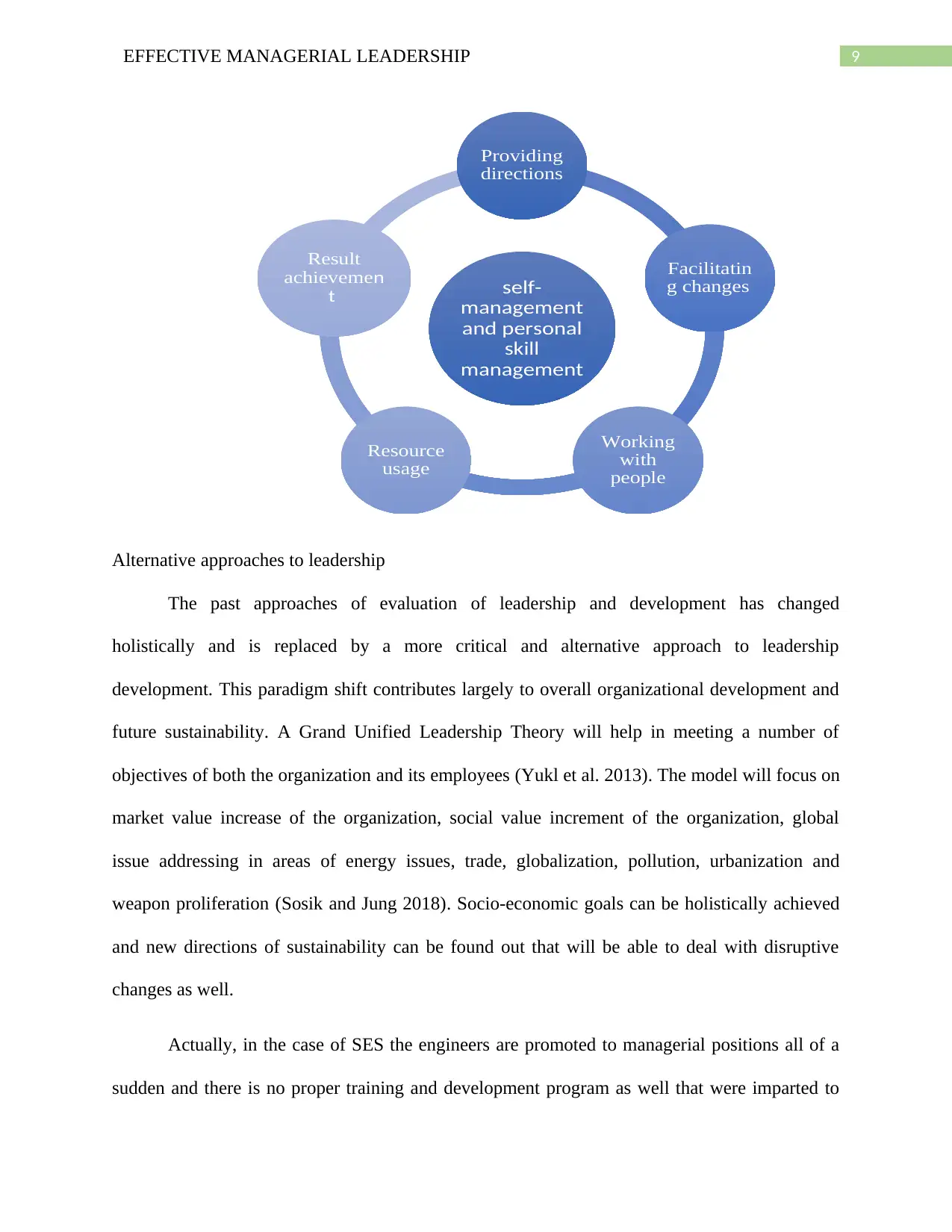
9EFFECTIVE MANAGERIAL LEADERSHIP
Alternative approaches to leadership
The past approaches of evaluation of leadership and development has changed
holistically and is replaced by a more critical and alternative approach to leadership
development. This paradigm shift contributes largely to overall organizational development and
future sustainability. A Grand Unified Leadership Theory will help in meeting a number of
objectives of both the organization and its employees (Yukl et al. 2013). The model will focus on
market value increase of the organization, social value increment of the organization, global
issue addressing in areas of energy issues, trade, globalization, pollution, urbanization and
weapon proliferation (Sosik and Jung 2018). Socio-economic goals can be holistically achieved
and new directions of sustainability can be found out that will be able to deal with disruptive
changes as well.
Actually, in the case of SES the engineers are promoted to managerial positions all of a
sudden and there is no proper training and development program as well that were imparted to
self-
management
and personal
skill
management
Providing
directions
Facilitatin
g changes
Working
with
people
Resource
usage
Result
achievemen
t
Alternative approaches to leadership
The past approaches of evaluation of leadership and development has changed
holistically and is replaced by a more critical and alternative approach to leadership
development. This paradigm shift contributes largely to overall organizational development and
future sustainability. A Grand Unified Leadership Theory will help in meeting a number of
objectives of both the organization and its employees (Yukl et al. 2013). The model will focus on
market value increase of the organization, social value increment of the organization, global
issue addressing in areas of energy issues, trade, globalization, pollution, urbanization and
weapon proliferation (Sosik and Jung 2018). Socio-economic goals can be holistically achieved
and new directions of sustainability can be found out that will be able to deal with disruptive
changes as well.
Actually, in the case of SES the engineers are promoted to managerial positions all of a
sudden and there is no proper training and development program as well that were imparted to
self-
management
and personal
skill
management
Providing
directions
Facilitatin
g changes
Working
with
people
Resource
usage
Result
achievemen
t
⊘ This is a preview!⊘
Do you want full access?
Subscribe today to unlock all pages.

Trusted by 1+ million students worldwide
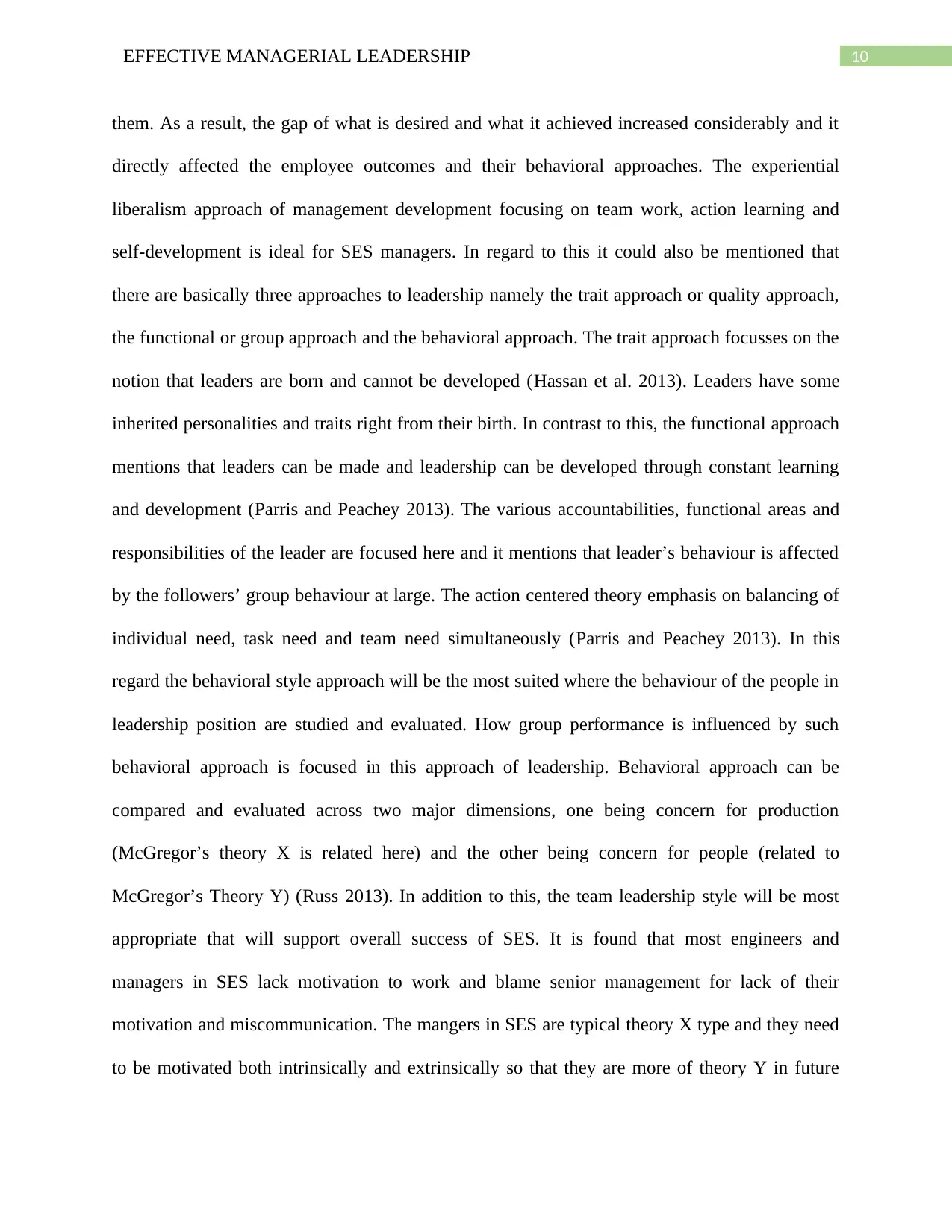
10EFFECTIVE MANAGERIAL LEADERSHIP
them. As a result, the gap of what is desired and what it achieved increased considerably and it
directly affected the employee outcomes and their behavioral approaches. The experiential
liberalism approach of management development focusing on team work, action learning and
self-development is ideal for SES managers. In regard to this it could also be mentioned that
there are basically three approaches to leadership namely the trait approach or quality approach,
the functional or group approach and the behavioral approach. The trait approach focusses on the
notion that leaders are born and cannot be developed (Hassan et al. 2013). Leaders have some
inherited personalities and traits right from their birth. In contrast to this, the functional approach
mentions that leaders can be made and leadership can be developed through constant learning
and development (Parris and Peachey 2013). The various accountabilities, functional areas and
responsibilities of the leader are focused here and it mentions that leader’s behaviour is affected
by the followers’ group behaviour at large. The action centered theory emphasis on balancing of
individual need, task need and team need simultaneously (Parris and Peachey 2013). In this
regard the behavioral style approach will be the most suited where the behaviour of the people in
leadership position are studied and evaluated. How group performance is influenced by such
behavioral approach is focused in this approach of leadership. Behavioral approach can be
compared and evaluated across two major dimensions, one being concern for production
(McGregor’s theory X is related here) and the other being concern for people (related to
McGregor’s Theory Y) (Russ 2013). In addition to this, the team leadership style will be most
appropriate that will support overall success of SES. It is found that most engineers and
managers in SES lack motivation to work and blame senior management for lack of their
motivation and miscommunication. The mangers in SES are typical theory X type and they need
to be motivated both intrinsically and extrinsically so that they are more of theory Y in future
them. As a result, the gap of what is desired and what it achieved increased considerably and it
directly affected the employee outcomes and their behavioral approaches. The experiential
liberalism approach of management development focusing on team work, action learning and
self-development is ideal for SES managers. In regard to this it could also be mentioned that
there are basically three approaches to leadership namely the trait approach or quality approach,
the functional or group approach and the behavioral approach. The trait approach focusses on the
notion that leaders are born and cannot be developed (Hassan et al. 2013). Leaders have some
inherited personalities and traits right from their birth. In contrast to this, the functional approach
mentions that leaders can be made and leadership can be developed through constant learning
and development (Parris and Peachey 2013). The various accountabilities, functional areas and
responsibilities of the leader are focused here and it mentions that leader’s behaviour is affected
by the followers’ group behaviour at large. The action centered theory emphasis on balancing of
individual need, task need and team need simultaneously (Parris and Peachey 2013). In this
regard the behavioral style approach will be the most suited where the behaviour of the people in
leadership position are studied and evaluated. How group performance is influenced by such
behavioral approach is focused in this approach of leadership. Behavioral approach can be
compared and evaluated across two major dimensions, one being concern for production
(McGregor’s theory X is related here) and the other being concern for people (related to
McGregor’s Theory Y) (Russ 2013). In addition to this, the team leadership style will be most
appropriate that will support overall success of SES. It is found that most engineers and
managers in SES lack motivation to work and blame senior management for lack of their
motivation and miscommunication. The mangers in SES are typical theory X type and they need
to be motivated both intrinsically and extrinsically so that they are more of theory Y in future
Paraphrase This Document
Need a fresh take? Get an instant paraphrase of this document with our AI Paraphraser
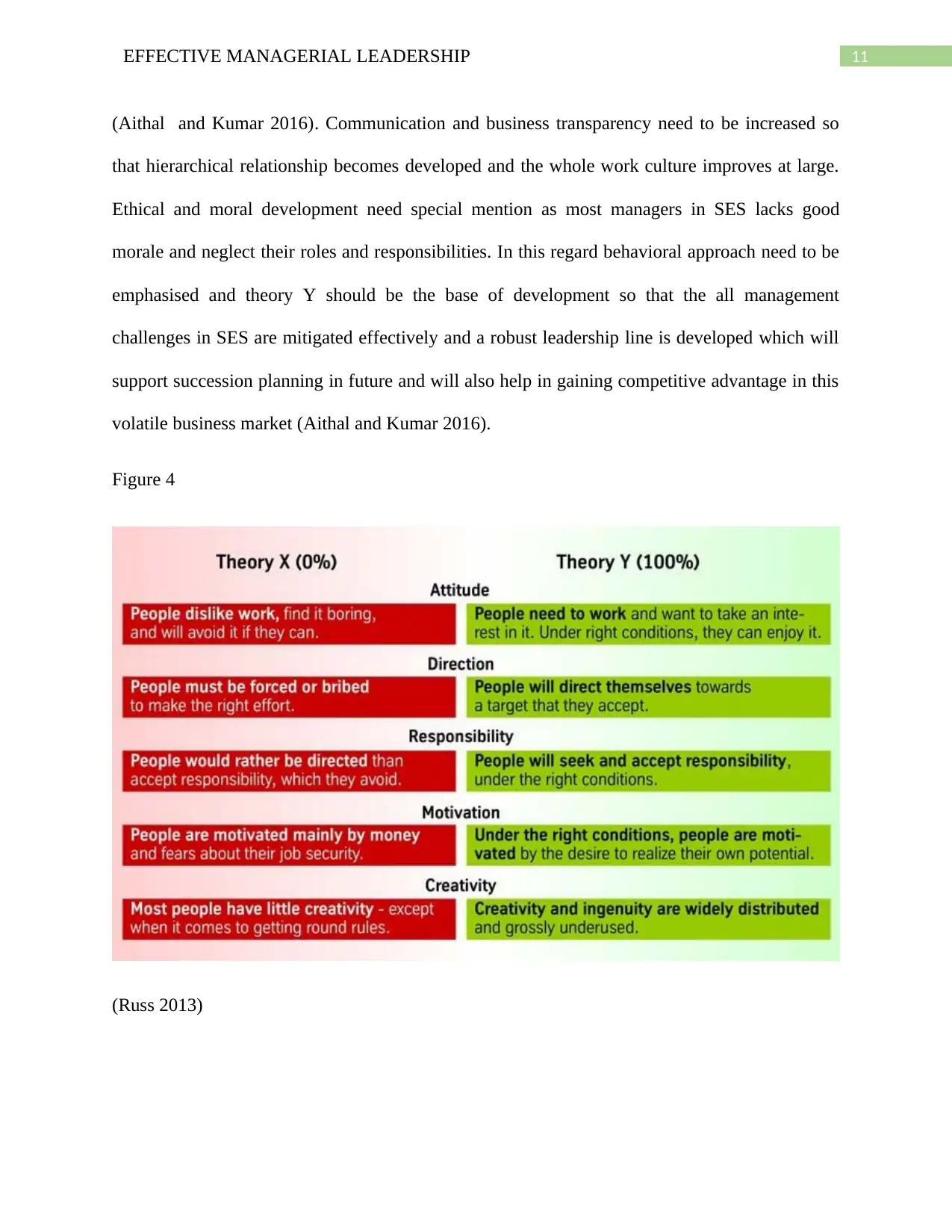
11EFFECTIVE MANAGERIAL LEADERSHIP
(Aithal and Kumar 2016). Communication and business transparency need to be increased so
that hierarchical relationship becomes developed and the whole work culture improves at large.
Ethical and moral development need special mention as most managers in SES lacks good
morale and neglect their roles and responsibilities. In this regard behavioral approach need to be
emphasised and theory Y should be the base of development so that the all management
challenges in SES are mitigated effectively and a robust leadership line is developed which will
support succession planning in future and will also help in gaining competitive advantage in this
volatile business market (Aithal and Kumar 2016).
Figure 4
(Russ 2013)
(Aithal and Kumar 2016). Communication and business transparency need to be increased so
that hierarchical relationship becomes developed and the whole work culture improves at large.
Ethical and moral development need special mention as most managers in SES lacks good
morale and neglect their roles and responsibilities. In this regard behavioral approach need to be
emphasised and theory Y should be the base of development so that the all management
challenges in SES are mitigated effectively and a robust leadership line is developed which will
support succession planning in future and will also help in gaining competitive advantage in this
volatile business market (Aithal and Kumar 2016).
Figure 4
(Russ 2013)
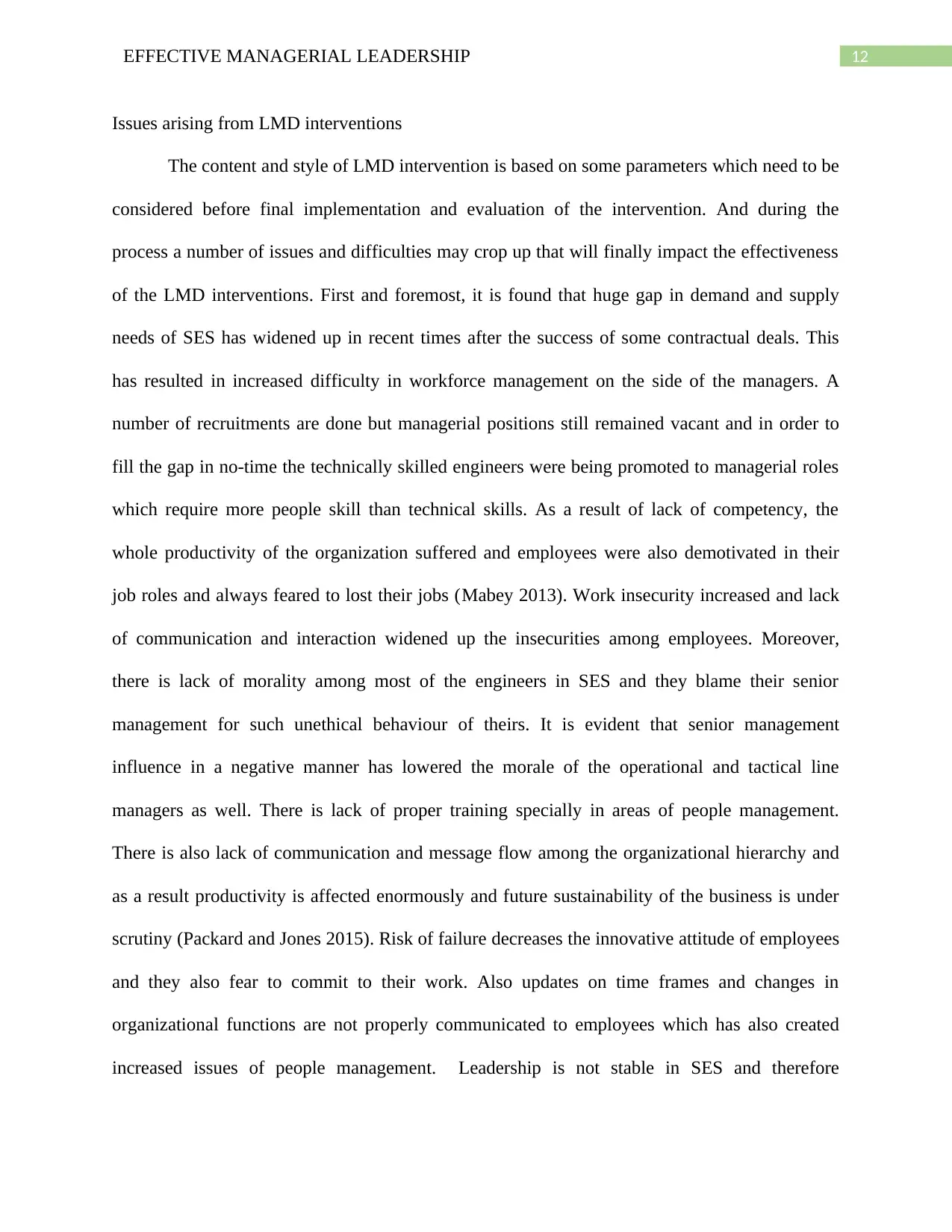
12EFFECTIVE MANAGERIAL LEADERSHIP
Issues arising from LMD interventions
The content and style of LMD intervention is based on some parameters which need to be
considered before final implementation and evaluation of the intervention. And during the
process a number of issues and difficulties may crop up that will finally impact the effectiveness
of the LMD interventions. First and foremost, it is found that huge gap in demand and supply
needs of SES has widened up in recent times after the success of some contractual deals. This
has resulted in increased difficulty in workforce management on the side of the managers. A
number of recruitments are done but managerial positions still remained vacant and in order to
fill the gap in no-time the technically skilled engineers were being promoted to managerial roles
which require more people skill than technical skills. As a result of lack of competency, the
whole productivity of the organization suffered and employees were also demotivated in their
job roles and always feared to lost their jobs (Mabey 2013). Work insecurity increased and lack
of communication and interaction widened up the insecurities among employees. Moreover,
there is lack of morality among most of the engineers in SES and they blame their senior
management for such unethical behaviour of theirs. It is evident that senior management
influence in a negative manner has lowered the morale of the operational and tactical line
managers as well. There is lack of proper training specially in areas of people management.
There is also lack of communication and message flow among the organizational hierarchy and
as a result productivity is affected enormously and future sustainability of the business is under
scrutiny (Packard and Jones 2015). Risk of failure decreases the innovative attitude of employees
and they also fear to commit to their work. Also updates on time frames and changes in
organizational functions are not properly communicated to employees which has also created
increased issues of people management. Leadership is not stable in SES and therefore
Issues arising from LMD interventions
The content and style of LMD intervention is based on some parameters which need to be
considered before final implementation and evaluation of the intervention. And during the
process a number of issues and difficulties may crop up that will finally impact the effectiveness
of the LMD interventions. First and foremost, it is found that huge gap in demand and supply
needs of SES has widened up in recent times after the success of some contractual deals. This
has resulted in increased difficulty in workforce management on the side of the managers. A
number of recruitments are done but managerial positions still remained vacant and in order to
fill the gap in no-time the technically skilled engineers were being promoted to managerial roles
which require more people skill than technical skills. As a result of lack of competency, the
whole productivity of the organization suffered and employees were also demotivated in their
job roles and always feared to lost their jobs (Mabey 2013). Work insecurity increased and lack
of communication and interaction widened up the insecurities among employees. Moreover,
there is lack of morality among most of the engineers in SES and they blame their senior
management for such unethical behaviour of theirs. It is evident that senior management
influence in a negative manner has lowered the morale of the operational and tactical line
managers as well. There is lack of proper training specially in areas of people management.
There is also lack of communication and message flow among the organizational hierarchy and
as a result productivity is affected enormously and future sustainability of the business is under
scrutiny (Packard and Jones 2015). Risk of failure decreases the innovative attitude of employees
and they also fear to commit to their work. Also updates on time frames and changes in
organizational functions are not properly communicated to employees which has also created
increased issues of people management. Leadership is not stable in SES and therefore
⊘ This is a preview!⊘
Do you want full access?
Subscribe today to unlock all pages.

Trusted by 1+ million students worldwide
1 out of 19
Related Documents
Your All-in-One AI-Powered Toolkit for Academic Success.
+13062052269
info@desklib.com
Available 24*7 on WhatsApp / Email
![[object Object]](/_next/static/media/star-bottom.7253800d.svg)
Unlock your academic potential
Copyright © 2020–2025 A2Z Services. All Rights Reserved. Developed and managed by ZUCOL.





